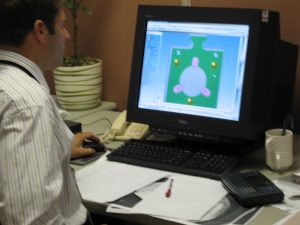
In a manufacturing environment, we can quickly move to a visual display of the work to allow our team to show the status of work. With a worldwide shift from a manufacturing workforce to an economy based more on knowledge work, the structure of the workforce is changing. The interaction of technology with workers’ intellectual and human capital has created a new class of worker in today’s economy – the knowledge worker. Knowledge work deals with the capital that is knowledge. This includes software engineers, physicians, pharmacists, architects, scientists, engineers, accountants, lawyers, and academics whose jobs are to “think for a living”.
Peter Drucker is credited with popularising the term ‘knowledge worker’ as long ago as 1968 (Drucker 1968). Back then he argued, ‘Today the centre is the knowledge worker, the man or woman who applies to productive work ideas, concepts, and information rather than manual skill or brawn…Where the farmer was the backbone of any economy, a century or two ago…knowledge is now the initial cost, the principal investment, and the main product of the advanced economy and the livelihood of the largest group in the population’ (p.264). Even in its basic form the term “knowledge worker” hints at a shift in the nature of some jobs where knowledge – not physical work – is increasingly becoming the core skill required in the future job market.
How Do We Continue Lean Values in a Knowledge Environment?
We start with the essential Lean principle of eliminating waste, which leads us to continuous improvement that drives waste out of a process. One of causes of waste in knowledge work is the time spent each and every day collecting together project status information from each staff is an incredibly wasteful process.
Imagine that you are the lead engineer overseeing 20 build projects with a staff of 10 engineers and detailed draftsman. Every day you are required to be across all of the projects and be able to make critical calls to allocated resources as demands change. Then on top this you need to be checking with three or more different people to be sure that you’ve accomplished everything you need to do for the day. It’s possible to get everything taken care of, but it’s a far cry from efficient — this complicated process introduces waste and slows down your team’s ability to deliver needed value to customer’s projects.
Commonly these projects are controlled by a project schedule or project software that has defined tasks and durations. However, with the rapid change in demand of customer orders and in general needing to deal with shorter and shorter lead-times, it becomes increasingly difficult to plan out projects in detail when compared to the time of just starting the project and working out the detail as needed later on. It is in this environment where a visual management board, also known as a Kanban board, can have a sudden impact on understanding where everyone is at and assist in developing a faster way of reaching a single appreciation of the work in progress.
A Kanban board is a more efficient and less frantic method than having multiple people to contact each day, just to define the current status of the work. A Kanban board displays everything required to make informed decisions including:
1. Which work to prioritise first.
2. Which resource to use next
3. Ability to collect valuable metrics
4. At a glance view the whole workload picture
5. Timing, flow and resource assignments
To grasp the concept of Kanban, there are several fundamental Lean principles built into a Kanban board that support how a team can practice and build upon continuous improvement cycles. We will discuss the importance of understanding your entire value stream, the creating knowledge process and being respectful towards the people involved.
Seeing the Whole Value Stream
Within Lean, “Seeing the Whole” is a key concept for understanding the entire value stream. It can be challenging to have a single and shared view of what the team is facing. It is also problematic to track the entire team’s capacity when you have to go and interpret what each team member is working on. These interactions through the day are not the best use of your time or theirs. Visual management is essential to managing a team’s work in progress and display all the activities in one place.
Create Knowledge
If you only work within the functions of your role within a company, you’re missing an important opportunity to cross-train yourself and those in your team. It is amazing what a set of fresh eyes can bring to solving a problem or a task that is falling behind. It happens so many times that after collaborating with a co-worker, a solution can be found to progress the work or aid in selecting the right solution. Every time this happens is an opportunity to grow — by hearing new ideas and understanding new perspectives for the team and yourself.
It is equally valuable to see the work that someone else is doing. Visibility of the work provides the opportunity to help your team deliver value faster. By keeping individual projects separate from each other, the opportunities to focus on both little and large problems across all projects as a whole is hidden.
With a kanban board setup, when a concern arises, the team can see the issue on the board and can immediately start to develop a shared response and begin working towards a solution together. Often this will happen automatically soon after the kanban board is working with deadlines, metrics and schedule information. All of these visual information triggers the sharing of information leading towards new ideas and help to progress the problem towards a conclusion. Therefore it is important to have the information displayed to the team as without being able to visualise that there is a problem first, the ability to focus the team together is lost. Without these visualisation techniques of the Kanban board, it can be difficult to see how all work is connected.
Being Respectful Towards the People
Wasting someone’s time is most disrespectful, and we do this sometimes unintentionally with running a simple team status meeting to provide information. Many of these status meetings go around the room, as each team member reports information on their tasks. While it is important to have a say most of the attendees are disinterested in most of what is being said, while the others wait for their turn to talk. As a result in these type of meeting we are, in fact not talking to each other – we were talking at each other. The meeting is missing the opportunity to improve the quality of the meeting itself and to remove obstacles out of each other’s way so the projects can get done.
If we cannot improve the quality of our communication, it becomes a much harder task to improve the quality of our work. Finding out that you are always on a different page from your team can be frustrating. In the end, miscommunications result in complexity, frustration, and increasing anxiety levels. As Deming said, “A bad system will beat a good person every time.” [February 1993 Deming Four Day seminar in Phoenix, Arizona.]
How do Kanban Boards Assist?
Having a single Kanban board allows a team to visualise the entire process and enables more time in the meeting to focus on the essential aspect of work such as deadlines, changes in priorities or arising concerns. Then at the daily team meeting, we can create a single point meeting that addresses communication problems by having to speak to each person and many people prefer visual information because it is quicker to process.
The daily team standup meeting is around 10 minutes duration to cover project status, metrics, task assignments and problem-solving. Most of this discussion ends up eliminating the need for lengthy status meetings and long emails.
Creating a Kanban Board
To get started, refer to “Personal Kanban Mapping work” by Jim Benson, 2011. It is a great starting point into the “World of Post-It-Notes” and how to organise work tasks. Then just do it by developing a mockup to test the visualising of workflow steps needed to progress the work.
Once the mockup is ready, put it to work and test it out in the real world Refine by understanding “What works well?” and “What is needed?” to support Kanban.
In conclusion, as work transitions towards knowledge work, visualising the tasks and priorities for our team is more important than it has ever been. When you begin to define your visual management or Kanban board, you need to understand how adding value is created in your processes, understanding how you collect your company knowledge and ensure you continue to respect your people’s abilities and skills. Then you and your team can trial your mockup Kanban board and daily meetings, and to continuously improve your processes of managing your knowledge work.




